Salmon River Restoration Council
- Overview
- Mission & Goals
- Accomplishments
- Our Board
- Our Funders
- Watershed Center
- Links
Overview
Who We Are
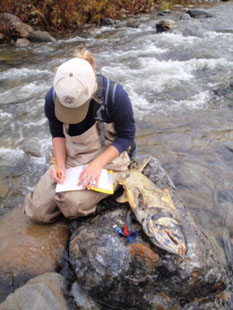
Collecting data on a Chinook carcassPhoto: Sarah Burstein
The Salmon River Restoration Council (SRRC) is a non-profit organization that has been serving California's Salmon River watershed and its community since 1992. We have a permanent staff of about ten plus additional seasonal project staff, field crews, and a large, dedicated group of volunteers and members. The SRRC is a chief promoter of cooperative actions within the local community and among the stakeholders of the Salmon River watershed.
What We Do
Our mission is to assess, protect, and maintain the Salmon River ecosystem with the active participation of the local community, focusing on the anadromous fisheries resource and the development of a sustainable economy.
Through cooperative management activities, the SRRC addresses the distinct needs of the Salmon River watershed that arise due to the impacts of past catastrophic fires and fire management, timber harvest, road construction, mining, grazing, floods, residential and recreational use, as well as the inherent challenges faced in the remote, rugged mountain environment.
We work to foster the health and well being of our region and its inhabitants through a variety of projects and programs. We are an equal opportunity provider.
Our long term goals are to enlist community members in a cooperative approach to protect and restore the Salmon River ecosystem, to increase public awareness and good stewardship through education and outreach, to create economic stability in the community by diversifying restoration based job opportunities, to promote the collaborative stakeholder partnerships needed for the restoration of the Salmon River, to help fill the resource management gaps left by traditional large governmental agencies which often have a difficult time implementing small or non-traditional projects, and to work to increase ecosystem resiliency in a changing environment through program implementation.
SRRC's Beginning
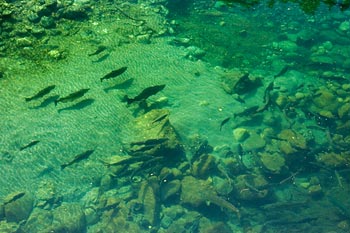 Fall Chinook in the Salmon RiverPhoto:Scott Harding
Fall Chinook in the Salmon RiverPhoto:Scott HardingIn 1992, a group of Salmon River community members received support from the Klamath River Fisheries Task Force to host a series of cooperative workshops for the communities in the Salmon River subbasin. These workshops were aimed at increasing local awareness to help protect and restore the dwindling populations of Spring Chinook salmon and Summer Steelhead in the Salmon River. The community response was overwhelmingly positive and illegal harvest of these species noticeably reduced.
In response to the local community's desire to protect and restore the Salmon River anadromous fisheries, the Salmon River Community Restoration Program was created in 1993. Through the vehicle of the Community Restoration Program, local involvement and broadened volunteer efforts increased and led to the formation of the Salmon River Restoration Council, which became a 501 (c)(3) non-profit corporation in 1995.
To date the SRRC has sponsored more than 1,900 restoration related workshops, workdays, and field trips. Community members, staff, technical specialists, and others have contributed over 100,763 volunteer hours to watershed restoration activities. These activities have helped to increase coordination and cooperation between diverse stakeholders.
Mission Statement
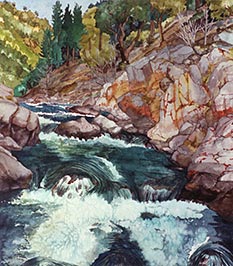
Artwork by Sarah Hugdahl
The mission of the Salmon River Restoration Council is to assess, protect, restore and maintain the Salmon River ecosystems with the active participation of the local community, focusing on restoration of the anadromous fisheries resources and the development of a sustainable economy. We provide assistance and education to the general public and cooperating agencies by facilitating communication and cooperation between the local communities, managing agencies, Native American Tribes, and other stakeholders.
Vision
We envision a sustainable Salmon River watershed that has healthy forests and streams, with natural fire regimes and abundant native fish and wildlife populations that allow for a harvestable surplus of resources, managed using best land practices and traditional cultural knowledge.
We envision a well-informed Salmon River community that draws its sustenance from and lives in harmony with the environment, respects its own diversity, values the complexity of the natural world, and accepts responsibility for the social, economic, and ecological well-being of present and future generations through individual and collective action.
We seek to encourage and enhance the exchange of knowledge among all community members in order to achieve this vision.
Long Term Goals
- Enlist community members in a cooperative approach to protect and restore the Salmon River aquatic and terrestrial ecosystems, emphasizing the anadromous fisheries and biologically unique features.
- Develop and implement effective education, communication and outreach programs as a tool to increase public awareness and encourage our community to become effective stewards of the watershed.
- Promote economic stability in the community by diversifying job opportunities based on restoration, conservation, and management of the Salmon River aquatic and terrestrial ecosystems.
- Develop collaborative approaches and partnerships among agencies and stakeholders that emphasize cooperation and shared effort needed for the protection, restoration, and enhancement of the Salmon River.
- Assist in filling in the resource management gaps left by traditional large governmental agencies, such as the Forest Service, who have a difficult time with small or non-traditional projects – both in terms of conception and implementation.
- Work to increase ecosystem resiliency in a changing environment through the implementation of program specific goals.
Accomplishments
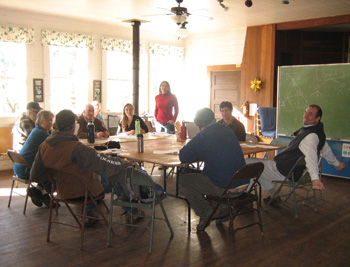 Some SRRC staff and board members in 2012
Some SRRC staff and board members in 2012The Salmon River Restoration Council is proud to have made many significant contributions to the community and watershed. Our work is made possible by a dedicated staff, numerous volunteer workers, our board of directors, funders, members, and significant community support. Below are some of our accomplishments.
Please read our Accomplishments Reports for a more detailed look.
General
- Produced an annual Community Restoration Plan to guide Salmon River restoration
- Co-authored the Salmon River Subbasin Restoration Strategy
- Operated the Salmon River Watershed Center in Sawyers Bar since 1996
- Provided restoration jobs to Salmon River residents since 1992, providing a sustainable economic base in our remote area
Fisheries
- Coordinated and participated in all the Salmon River fisheries surveys since 1992
- Coordinated the Spring Chinook Voluntary Recovery Group
- Developed a draft Salmon River Limiting Factors Analysis for Spring Chinook
- Attained crucial, otherwise unavailable population data for Salmon River and Klamath Basin Spring Chinook and other anadromous fish
- Co-coordinated two annual Spring Chinook Symposiums with the Salmonid Restoration Federation
- Substantially decreased the illegal harvest of Salmon River Spring Chinook through poaching prevention workshops and education
- Assessed and mapped Salmon River thermal refugia areas
- Enhanced cold water refugia areas and rearing habitat on prioritized river sites and tributaries
- Operated the Salmon River juvenile outmigration screw trap since 2001
Noxious Weeds
- Launched the most effective manual noxious weed eradication effort in the region, controlling 20 prioritized noxious weed species without the use of toxic chemicals
- Reduced or eliminated spotted knapweed populations on over 270 sites. This program has reduced spotted knapweed plant populations in the watershed by 99%
- Completed the Salmon River Cooperative Noxious Weed Plan
Fire, Fuels, & Forestry
- Facilitated the Salmon River Fire Safe Council since 2000
- Completed the Salmon River Community Wildfire Protection Plan and several detailed neighborhood fire safe plans
- Identified and mapped all Salmon River tanker fill sites and helispots
- Completed over 1,000 acres of fuels reduction work on 169 private land parcels
- Provided strategic local knowledge of fire history in the watershed and GIS map products to federal fire fighting efforts during the wildfires of 2006, 2008, 2013, 2014, and 2017
- Implemented nearly 100 acres of low-intensity prescribed fire on private properties across the watershed with the Klamath River TREX program in 2014 and 2015
Watershed Education, Outreach, and Community Involvement
- Provided watershed education to Salmon River schools since 1994
- Produced educational and outreach tools to promote Salmon River restoration including brochures, newsletters, website, and monthly activities calendar
- Sponsored over 2,000 restoration-related activities since 1996 including workshops, workdays, and trainings
- Produced and posted maps and detailed infomation on Salmon River fishing regulations to help anglers maintain compliance with the law
Watershed Monitoring
- Monitored baseline river conditions since 1996
- Collected over 1,500,000 temperature data points for the Salmon River from approximately 50 sites since 1997
- Assisted in the development and implementation of the Salmon River TMDL
- Obtained a permit for the installation of a full-time, telemetric water quality monitoring station on the Salmon River that is operated by the Karuk Tribe
Roads Stewardship and Restoration
- Completed sediment source assessments for all federal and most private roads in the watershed, totaling over 900 miles of road.
- Engaged in the feasibility studies and NEPA assessments and cooperated in the removal of several major fish passage barriers including Merrill Creek, Taylor Creek, Hotelling Creek and Kelly Gulch.
- Removed two dams on White's Gulch in 2008, which were acting as fish passage barriers.
River Clean-Up
- Completed the “Leave No Junker Behind” project in 2006. Over 330 junk vehicles, 625 tons (32 semi loads) of scrap metal, and 37 tons of tires were removed from the watershed and recycled. This project involved more than 2000 hours of volunteer work.
- Since 1997 we’ve removed over 120 pickup loads of trash and 22 tons of debris (including a 20 ton bridge) from the watershed during River Clean-Up days. More than 600 volunteer hours have been contributed.
- Removed over 800 feet of life-threatening metal cables from the river channel.
Board of Directors
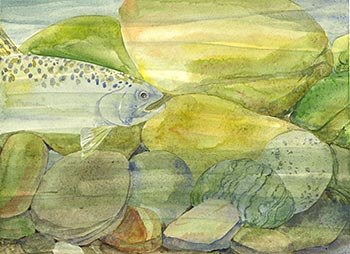 Artwork by Sarah Hugdahl
Artwork by Sarah HugdahlThe SRRC is guided by a nine-member volunteer board of directors who serve one-year terms.
Toz Soto, President
Karuk Tribe Fisheries Biologist
Josh Saxon, Vice-President
Karuk Tribal Representative
Kathy McBroom, Secretary & Treasurer
SRRC Office Manager
Petey Brucker
Community member
Creek Hanauer
Community member
Will Harling
MKWC Executive Director
Crystal Robinson
Quartz Valley Indian Reservation Environmental Director
Jennifer Silveira
Retired USFWS habitat restoration specialist
Erica Terence
Karuk Tribe DNR Fire & Fuels administrative assistant
Our Funders
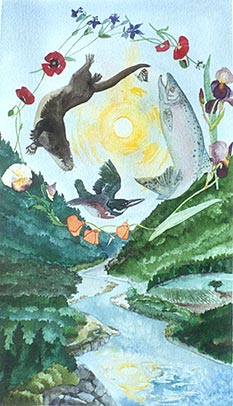
Artwork by Sarah Hugdahl
We would like to thank our current and past funders for their generous support. Without them, we would not be able to do our work.
Current Funders
Government Agencies
- Calif.
Department of Fish & Wildlife
- Calif. Department of Food & Agriculture
- CA Coastal Conservancy
- CAL FIRE
- US Fish & Wildlife Service
- US Forest
Service
Private Foundation Funders
- Clif Bar Family Foundation
- Firedoll Foundation
- Ford Family Foundation
- National Fish and Wildlife Foundation
- National Forest Foundation
- Patagonia Environmenal Grants
- Sidney Stern Memorial Trust
- Trees Foundation
- Yellow Chair Foundation
- Bigfoot Trail Alliance
- Bower Charitable Foundation
- Cereus Fund of the Trees Foundation
- Coalitions and Collaboratives, Inc.
- Wild Salmon Center
Other Funders
- Karuk Tribe
- Mid Klamath Watershed Council
- Fire Safe Council Grants Clearinghouse
- SRRC Donors and Members (join
now!)
Past Funders
- Ayers Family Fund
- Bank of America
- Bella Vista Foundation
- Calif. Department of Conservation
- CA Fire Safe Council
- Conservation Technology Support Program
- Dancing Tides Foundation
- ESRI
- Fish America Foundation
- For the Sake of the Salmon
- Frank Colver
- Hewlett Packard
- Humboldt Area Foundation
- Jiji Foundation
- Klamath Fisheries Task Force
- McConnell Foundation
- Mountaineers Foundation
- NOAA Restoration Center
- Norcross Wildlife Foundation
- Outback Power
- North Coast Regional WQCB
- Sacramento Regional Foundation
- Shasta Regional Community Foundation
- Siskiyou County Department of Agriculture
- Shasta Community Regional Foundation
- Sustainable Northwest
- The Strong Foundation for Environmental Values
- Trimble
- US Department of Agriculture
- US Bureau of Reclamation
- Various private donors
Salmon River Watershed Center
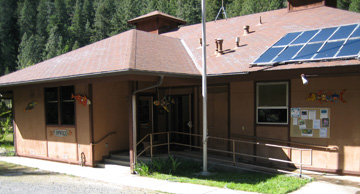
SRRC's Salmon River Watershed Center
The SRRC has operated the Salmon River Watershed Center in Sawyers Bar since 1996.
This large multipurpose facility is open to the public and serves as a community center for restoration meetings, a library with resource-related media, and an office for SRRC staff. The Watershed Center provides a space for many of the educational outreach events the SRRC puts on. The building is fully solar-powered and off-grid.
Services Available
- Public internet and computer access (including WiFi)
- Photocopies
- Scanning, phone & fax
- Library (books, videos, periodicals, etc.)
- Watershed and river information (including a virtual history archive)
- Meeting space
Directions to the Salmon River Watershed Center
Address: 25631 Sawyers Bar Road, Sawyers Bar, CA 96027
The Watershed Center is located on the downriver end of Sawyers Bar in the large brown building (formerly the Sawyers Bar School). The nearest milemarker on the road is Mile 14 and we are about 1/4 mile upriver (at 14.25).
Get a detailed map and driving directions from your location.
Driving times (approximate)
From I-5 at Yreka: 1.5 hours (road sometimes closes
in winter after storms)
From I-5 at Weed: 2 hours (via Etna, road sometimes closes
in winter after storms)
From Highway 96 at Somes Bar: 1 hour, 10 minutes
From US 101 at Arcata: 3.5 hours
Links to Our Cooperators
Tribes
Karuk Tribe of California
www.karuk.us
Yurok Tribe
www.yuroktribe.org
Non-Governmental Organizations
Mid Klamath Watershed Council
www.mkwc.org
Fire Safe Council of California
www.firesafecouncil.org
Klamath Riverkeeper
www.klamathriverkeeper.org
Klamath Siskiyou Art Center
www.ksartcenter.org
Northcoast Environmental Center
www.yournec.org
Mattole Restoration Council
www.mattole.org
Redwood Community Action Agency, Natural Resource Services
naturalresourcesservices.org
Salmonid Restoration Federation
www.calsalmon.org/index.php
Bigfoot Trail Alliance
bigfoottrail.org
Watershed Research and Training Center
thewatershedcenter.com
Governmental Organizations
California Department of Forestry and Fire Protection
(CDF)
www.fire.ca.gov
California Department of Fish and Wildlife
www.dfg.ca.gov
US Fish and Wildlife Service
www.fws.gov/yreka
NOAA Fisheries Service
www.nmfs.noaa.gov
US Forest Service, Six Rivers National Forest
www.fs.fed.us/r5/sixrivers
US Forest Service, Klamath National Forest
www.fs.fed.us/r5/klamath
Natural Resource Conservation Service
www.ca.nrcs.usda.gov
North Coast Regional Water Quality Control Board
www.swrcb.ca.gov
Links to Other Resources
Klamath Restoration Agreements
klamathrestoration.org
Junction Elementary School – Watershed Ed Program
sisnet.ssku.k12.ca.us/~junctftp/watershed/index.html
Forks of Salmon Elementary School – Watershed
Ed Program
sisnet.ssku.k12.ca.us/~forksftp


Salmon River Restoration Council
PO Box 1089 | Sawyers Bar, CA | 96027
Salmon River (California)
530-462-4665
![]()